- Home
- Will Hobbs
Wild Man Island Page 7
Wild Man Island Read online
Page 7
The dog was acting like he had to get into the alcove. I was losing all patience. We were separated from the floor of the alcove by seven or eight feet of thin air. Even with dry footing I couldn’t make a leap like that, not from a standing start, and neither could he.
Now he was standing up against the trunk of a cedar that grew out of the ledge and leaned high over the gap. Barking and wagging his tail, the Newfie was acting like there was something up the tree. I hoisted myself up on the rocks for a look.
What I found was a small coil of rope on the shoulder of the first branch. The rope was tied to a jagged outcrop above. Soon I was back down on the ledge with the free end. It was braided from inner cedar bark, and obviously sturdy. Meant for swinging across to the alcove, to a food cache if I had at least one lucky bone in my body.
The dog was going crazy, and I was nearly as excited. “Okay, okay,” I said. “I’m hungrier than you are.” I swung across and landed easily on the floor of the alcove.
A few steps toward the interior of the alcove, and I could see that it was a good forty feet deep and twice that long. Another step, and my eyes took in more surprises than my brain could begin to process: a stone cooking hearth, a beautiful long table of polished cedar planks, a huge chair made from hide stretched over a bone frame, maybe whalebone.
I went straight to the hearth. I put my hand to the ashes in the fire pit. No hope of reviving them: they were as cold as I was. A large bowl carved from stone, with a big cedar spoon inside, had been left beside the fire pit. On all sides, there were prehistoric implements: mortar and pestle, a stone slab and grinding stone, baskets of many sizes, wooden storage boxes, a stone ax leaning against a neat stack of firewood. Close at hand was an ample supply of tinder including a bin full of old-man’s beard.
“Anybody home?” I called. The only reply was my echo. Next to the kitchen, neatly arranged on handcrafted shelves, were dozens and dozens of Harvard Classics and National Geographics.
The guard hairs on the back of my neck stood up. The alcove was full of hiding places. What if the wild man was here, right now, watching me?
Back at the ledge, the dog was barking. How was I supposed to get him across?
Everywhere my eyes fell, I found neatly arranged artifacts. Everything seemed to be made of wood, stone, sinew, shell, or bone: axes, mauls, scrapers, fish hooks, line, rope, bags, fishing nets, knives, spears, clubs, bows and arrows, atlatl darts, enough points to arm a clan of cavemen, the components of a bow drill for making fire.
Why would anyone live like this? Talk about survivalists. The guy must think the end of the world is at hand. He could be seriously on the run from the law, but what kind of criminal would go to all this trouble?
The front of the cave was shielded from outside view by the dense tops of towering spruces rooted on the slope far below. With a glance above me, I discovered a wooden ramp, well out of reach, that was drawn up against the underside of one of the branches. It was held by a rope that ran through a couple of pulleys carved from wood. The rope was tied off a few paces away to a branch at shoulder height. I lowered the ramp and the dog came bounding across.
Something to eat, there had to be something to eat. Fortunately, there was. I discovered all sorts of dried food stored in cleverly made cedar boxes: smoked salmon, venison jerky, mushrooms, vegetables, and herbs I couldn’t begin to identify. One box was filled to the top with small cakes made of berries, fat, and shreds of dried meat. Pemmican, that’s what they were. Drinking water was funneled from a collecting trough at the outer edge of the roof into storage in large wooden boxes.
The smoked salmon was delicious beyond belief. I wolfed the jerky and washed it down with water. The pemmican cakes were more filling than mincemeat pie, and the berries made them sweet. I fed the dog but he didn’t have nearly my appetite. It was all so filling I finally had to lay off. I was bloated.
Food in my belly warmed me some, but I was still shivering. I thought about trying to make a fire with the bow drill but I had a good idea how difficult that would be.
At the back of the alcove was a wooden bed, knee-high and cleverly constructed without a nail or screw. The mattress, under an outer layer of sewn-together hides, was stuffed with something firm yet comfortable. In cedar boxes close by I found handmade clothing, some of it leather and some woven from cedar bark. When I came across a pair of sandals—works of art compared to mine and a whole lot softer—I quickly tried them on. The fit was sloppy but good enough when I lashed them tight.
In another cedar box I discovered a bearskin sleeping bag, with the hide to the inside and the fur to the outside. I would sleep by the hearth, not in the bed. It might help if he caught me here. For a few hours I would have a roof over my head. At first light I’d stuff a hide bag with food, sling it over my shoulder, and keep marching.
Toward the far end of the alcove I came across the spot where the wild man must have made his points. Lithics were everywhere, flakes and larger fragments of stone. I was so young when my father died, I don’t have many memories, but I remember him chipping on stones, making arrowheads. I used to play at it alongside him, as close as he would let me get, knocking one stone against another. Sometimes the stones would break, and I would think I was getting somewhere.
An array of harpoons leaned against the back of the alcove. Some were lightweight, with points of bone and shell, some were heavy, with points of stone and barbs made from the tips of antlers. Next to them was a small stack of club-like devices. They were bulky at one end with wrappings of bark that had been slathered with pitch. Torches.
Standing there, I thought I heard a continuous rush of wind, and close by. This was odd; there wasn’t any wind in the trees.
I walked toward the source of the wind and discovered a crevice in the back of the alcove, a dark, jagged opening, man-high. Another step and I realized that the wind was rushing out through the crevice. The wind was coming from inside the mountain.
I moved in front of the opening. The wind was surprisingly strong. I knew what this was. This was how Lechuguilla, the famous cave in New Mexico, had been discovered.
This was a cave, the real thing. These cliffs must be karst limestone. This was the entrance to a cave! In fact, it looked a whole lot like the entrance to one of the half dozen caves my mother and I had been into with a caving club in Missouri the summer before.
The torches, I thought. The wild man must use them inside. Why does he go in there and what has he found? It was all too much to think about.
I had to rest. Across the fire pit from the dog, I stripped and bedded down in the bearskin bag. Free of my wet clothes, I was warm soon enough. In the gathering darkness I closed my eyes. I was torn between fear and a strange sense of peace. I pulled the bearskin bag over my shoulders, thinking about my mother and how she would tuck me in when I was little.
For now, at least, I was safe and warm. And I was at the entrance of a cave the likes of which my father had died trying to find.
14
I AWOKE TO A WILD WIND SWAYING the branches that shielded the alcove. My watch said it was four in the morning. I looked around for the dog, but he was gone. I hadn’t thought to pull the drawbridge up.
Get out of here, I told myself. Now, while you still can. Anyone who would live like this, you don’t want to meet up close. Some variety of crazy. Get up, get going, find some real help, get home.
I snatched up one of his hide bags and stocked it with food, enough for a week if I made it last.
I was about to go when something caught my attention. The low morning light, through a sudden break in the clouds, was shining into the alcove at an angle that bounced it off the ceiling and lit some kind of pattern on the back wall.
My eyes were drawn to a pair of finger-length curves. Man-made carvings? In a flash of recognition I saw tusks on a mammoth, a woolly mammoth standing on its hind legs. I stepped closer, astounded, only to make out hunters surrounding the mammoth, hunters with spears. My hand reached out a
nd touched. What an exquisite sculpture, all in relief, in limestone. All polished, all perfect.
I took a step back and realized there was more, much more: saber-toothed cats, giant bison and bears, ground sloths…it went on and on.
Another step back, and I could see that all the figures were carved within a much larger pattern…a map of the Americas, but noticeably different from our modern map.
I looked closely at Alaska, high above me on the wall, almost at the ceiling. Alaska was still connected to Asia.
Then I knew. This map was of the Americas during the Ice Age, when sea level was down, way down, and Alaska was connected by land to Siberia. I was looking at the famous land bridge! Walking large across that bridge was a band of hunters: men with spears, women with tumplines across their foreheads connected to baskets on their backs, the head of a baby sticking out of one of the baskets. I could see in a flash that these were the Clovis people, named after the first discovery of their spearpoints near Clovis, New Mexico.
The figures on the land bridge were heading for a deep furrow in the smooth limestone—the famous corridor through the ice sheet, the corridor that led south through interior Canada. As they emerged from the ice, in the heart of what is now the United States, that’s where the hunters were attacking the mammoth.
True enough, I thought, but that’s not the whole story. It’s a shame that all the archeology buffs, like the crazy Michelangelo who made this, are so stuck on the land bridge. It’s all that they know.
The more I looked, the more I saw. Here was the Mississippi River, the Missouri, the Colorado…. There was the Grand Canyon, and there were the mountain ranges: the Appalachians, the Rocky Mountains, the Sierras. Incredible.
My eyes scanned farther south, and I recognized the pyramids of the Aztecs and the Maya, a city on a mountain in South America that had to be Incan. Maybe it was Machu Picchu.
The light on the mural was dimming as clouds raced over the sun. I heard a rustle, like the sound of wings, close by in the alcove. I turned, expecting to see a bird. What I found was a giant of a man standing right next to me, little more than an arm’s length away.
I was so startled I could have dropped dead. I was looking up and into the cold eyes of the wild man himself. The scar running from forehead to cheekbone was fierce enough, but not as terrifying as his eyes, staring and pale and bloodshot. “What are you doing here?” he demanded.
His voice was gravelly and powerful. It reverberated like a mountain storm, like thunder. I reeled backward, barely keeping my feet.
“Your dog…” I began. I was in shock. I hadn’t heard him approaching, not at all.
The wild man was trembling, a mountain about to explode. I looked away; his raven was hopping around the hearth picking up bits of food I had dropped. “Your dog led me here,” I managed to say.
In his bark clothes and cone-shaped hat, the wild man towered over me. With his long gray hair and beard, his sheer size and musky animal smell, he was a nightmare up close. His hands were as big as hams, and his forearms were like fenceposts. Even his face was muscled, taut and tense as a pulled bowstring. He dismissed my answer without a word; it was all in the lift of his bristling black eyebrows and the suspicion in his pale blue eyes.
“Really,” I insisted. “I think it was because I had your spear. Your dog recognized the spear. But when you weren’t here, he left.”
The wild man wasn’t listening. Those eyes were staring at me with an mix of confusion, disbelief, and hostility. They went to the spear at the hearth, the one he’d left for me at the cannery. “Nobody has ever found this place before,” he said slowly. “Nobody.”
“I’m sorry,” I began. He raised his huge mitt of a hand, flecked with small scars, and cut me off.
“How long?” the wild man demanded. His hoarse voice hit me like a club.
“How long what?”
“Since the dog was here.”
“Only a few hours, I guess.”
The wild man didn’t say another word. He snatched up his spear and started toward the drawbridge.
I was thinking I’d give him five minutes, then I’d clear out. This guy was beyond spooky. I was relieved he hadn’t mentioned the bag over my shoulder or looked into it.
As he was leaving, he grabbed the rope that controlled the drawbridge. He walked across the drawbridge with the rope in his hand. At the far side, he started pulling on it.
The drawbridge started going up; it could be operated from either side. He was cutting me off, trapping me in the alcove!
I ran to the edge. The drawbridge was already high above me, and the wild man was securing the rope to the tree that grew from the other side. He was also tying off the rope I had used to swing into the alcove. I yelled, “Hey! What do you think you’re doing?”
He looked at me, said nothing. He wasn’t going to waste the words.
The raven flew to his shoulder, settled its wings, and squawked at me. With that the wild man turned his back and started down the ledges toward the creek.
“Hey!” I yelled after him. “You can’t do this!”
I heard nothing in return. I didn’t shout again. I had to think. I had to figure out what was going on.
“Nobody has ever found this place before”—that’s what he had said. What he meant was, he had a big, big problem now, and it was me.
The man had to be a fugitive, a very successful fugitive for a long time. He must have committed some awful crime. I should have taken that possibility more seriously. I’d turned his world upside down.
First, he was going to tend to his dog. Then he was going to deal with me.
How could he solve his problem, when I was the problem? If he pushed me off the cliff, or used one of his weapons on me, who would ever know?
No one. No one even knew I was on this island.
He was as cornered as I was. He was going to have to do something about me. Waiting for him to come back would be suicide.
I judged the leap it would take to reach the ledge on the other side. It just wasn’t possible.
I was frantic to get out of there. I leaned over the cliff looking for a way down. There were hardly any handholds, and it was a sickeningly far drop.
Tear his table apart and make a gangplank? The boards weren’t long enough, not nearly. Shinny down the trees that shielded the alcove? Impossible. The last forty feet there weren’t any branches, and the trunks were too big around to hang on to.
What about climbing? I thought desperately. I could climb to the limb that the drawbridge was suspended from. It might be possible to belly past the drawbridge and out onto the skinny end of the limb where it rested against the top branches of the tree on the other side.
I eyeballed it again. It was way risky, not a bit like climbing the apple trees in the orchard back home.
The cave. It came to me like a bolt from the blue: the cave was the answer. There was too much air moving through the entrance for it to be sealed. There had to be another opening.
If I could make fire with the wild man’s bow drill, I could use his torches.
I was caught between the devil and the deep blue sea. Climbing the tree was the devil. Going into the cave was the deep blue sea.
Now, choose.
15
WHAT WAS I DOING WRONG? I had the bowstring looped around the spindle, I was sawing back and forth with the bow. It was agony, and it was taking forever. The spindle was creating plenty of friction, but all I could manage was a thin plume of smoke. I could only hope that the wild man wasn’t finding his dog and wouldn’t find him anytime soon.
The base of the spindle squeaked as it drilled continuously in the socket. Heated sawdust was building up around the base of the spindle and turning black. Smoke kept rising, the cedar was smouldering—so why couldn’t I make flame?
Too much breath, maybe. Too much desperation. Gently, Andy, gently.
I had seen a bow drill demonstration once at the Museum of Natural History in Denver. It had look
ed so easy.
It wasn’t.
At last a tiny coal glowed orange and stayed orange. I gave it breath while feeding it old-man’s beard, not so much as to smother it, just enough to give it fuel and opportunity.
At last, a fragile wink of flame.
More old man’s beard, but gently.
Finally, fire.
With my free hand I reached for a torch, then brought its head close to the flame. That was all it took. The torch sputtered at first, then fingers of flame ran around and around it until the entire pitchy head was ablaze.
I threw the carrying strap of the hide bag over my neck and shoulder. In addition to the food, it had room for two spare torches. With a glance over my shoulder I started inside the cave. The wind nearly blew out the torch but it stayed lit. This is crazy, I thought, but I kept going.
The entrance passage was a long slide of loose rock. I took it sitting down. Water dripped from the ceiling. At the bottom of the slope was a large room lit with dim natural light. I stopped breathing when I saw dozens of bones and skulls. The wild man’s sandals had left marks here and there. I jumped to a grisly conclusion, and my heart started jackhammering.
With the torch a little closer, I saw that the skulls weren’t human after all. They were bear skulls. A few twists and turns, and I left behind the twilight zone, as cavers call the first stretch of dim natural light. From now on I would be totally blind if my torch failed. At the slightest hint it might go out, I’d light another one.
I followed the passage, always downhill, into caverns draped with stalactites, countless numbers of them hanging from the ceiling, and rows upon rows of organ pipes. They all dripped water. There wasn’t any wind that I could feel. I reassured myself that cave air slows almost to a standstill in big rooms. There had to be another opening.

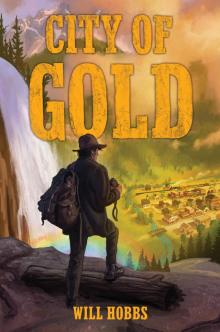 City of Gold
City of Gold Kokopelli's Flute
Kokopelli's Flute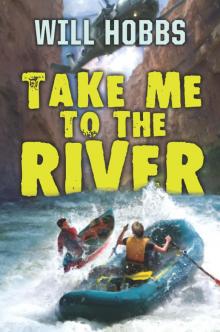 Take Me to the River
Take Me to the River Jackie's Wild Seattle
Jackie's Wild Seattle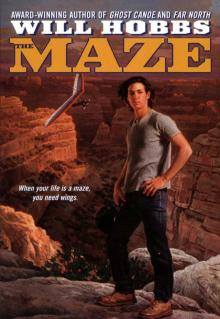 The Maze
The Maze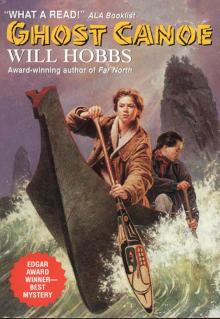 Ghost Canoe
Ghost Canoe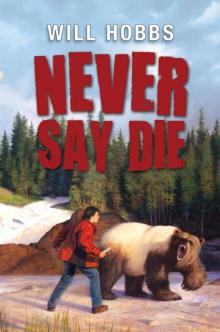 Never Say Die
Never Say Die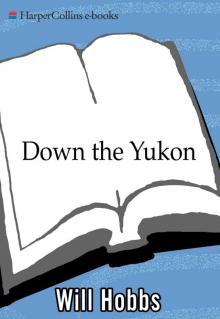 Down the Yukon
Down the Yukon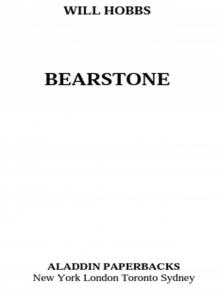 Bearstone
Bearstone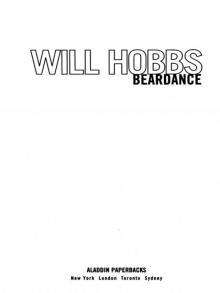 Beardance
Beardance Jason's Gold
Jason's Gold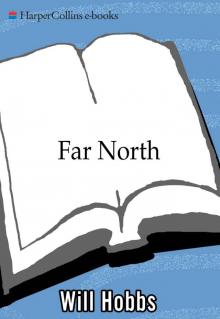 Far North
Far North The Big Wander
The Big Wander River Thunder
River Thunder Downriver
Downriver Go Big or Go Home
Go Big or Go Home Leaving Protection
Leaving Protection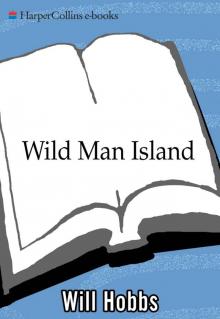 Wild Man Island
Wild Man Island